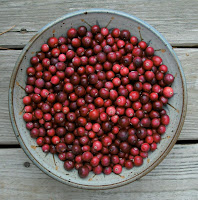This article originally appeared in the November 2008 issue of the Marquette Monthly.
 There are cranberry bogs throughout the U.P., I am sure, but my evidence is purely anecdotal. I have heard of bogs in Marquette and Alger counties, down in Nahma, and Whitefish Point is the Cranberry Capital of Michigan, as named this past spring by our esteemed legislature down in Lansing. Many years ago Henry Rowe Schoolcraft recorded "The Three Cranberries, A Chippewa Fable," but try today to get somebody official to talk about cranberries in the U.P. and maybe you'll run up against what I did: silence, referrals to folks on vacation, phone numbers that have been disconnected. So I went straight to the source, which of course, is the bog itself.
There are cranberry bogs throughout the U.P., I am sure, but my evidence is purely anecdotal. I have heard of bogs in Marquette and Alger counties, down in Nahma, and Whitefish Point is the Cranberry Capital of Michigan, as named this past spring by our esteemed legislature down in Lansing. Many years ago Henry Rowe Schoolcraft recorded "The Three Cranberries, A Chippewa Fable," but try today to get somebody official to talk about cranberries in the U.P. and maybe you'll run up against what I did: silence, referrals to folks on vacation, phone numbers that have been disconnected. So I went straight to the source, which of course, is the bog itself.
I remember my first day in a cranberry bog. I was sitting on an overturned plastic bucket gazing at golden orange and russet trees, trees that formed a ring around the bog, enclosing one in its particular essence. I had been feeling good because it was autumn and the smell of drying leaves and fresh north breezes was strong. I plunged my hands deep into a pail of firm, fresh-picked, blood-red cranberries, let them run through my fingers like jewels, realized being in this bog, miles and worlds away from anywhere, was bliss.
That day I had at first hunted in vain, trudging on and on through the short brambly cranberry bushes, treading carefully on spongy earth, spotting a berry here, a berry there, but not finding that one good spot to stop and pick. Finally, I just sat down on my settin’ bucket and studied the spot in front of me. At first, nothing; then I gently pushed aside some branches and there were berries—one, two, three and more. I picked the nearest ones, then reached deeper into the brambles, finding more and more berries as I went. I leaned forward until I was stretching and reaching for berries almost out of reach. I had to pull back. I took a breath and looked down. Right in front of me I had missed a berry or two. I took another breath and looked up, just for fun. Then I made a quarter turn on my bucket and studied the new spot in front of me. Aha. There they were. Berries—one, two, four and more.
The other morning a friend called and asked if I wanted to go cranberry picking. This bog abutted a river, and we paddled our canoe in as far we could. We had to cross a small area of muck on foot, and my friend, in the lead, got sucked down. The bog had her by the right ankle. She struggled, then we struggled together. We pulled and yanked and almost fell over. Finally, with a big slurp, her foot came free. Then, her other foot went down. We fought back. Free again! Sucked down again! The muck again grabbed her right foot and took it down to within an inch of the top of her black knee-high rubber boot. It was beginning to look as if we’d have to leave the boot behind, but then, with a final grunt and tug, the muck gave up the fight, boot and all. We headed into the bog. I disappeared from view twice, once stepping into water up to my knee and another time sinking to mid-thigh. With few cranberries to be found and perilous ground all around, we quickly headed out of that bog.
Cranberry bogs are fascinating places, and I have seen only these two, the one along the river and the secret bog I was introduced to last year. The ground, if not downright treacherous, is at best spongy and uneven, with dips and hillocks mostly hidden by bushes and long, tall grasses. The berries themselves grow low to the ground on tender green vines, often lying on silvery moss or soggy dead grass and twigs. Last year, in the secret bog, we came across numerous small, fluorescent orange mushrooms. In the river bog there are a number of hip-high wild roses waving their hips high, the hips looking surprisingly similar to the low-lying cranberries. The secret bog lies hidden in the woods, a reminder, perhaps, of what used to be—a glacier, a lake. A friend who has picked there for many years relates that there used to be a pond, with ducks, and then she tells the tale of a family in a row boat that went cranberry picking one day and never returned.
Over just north of Whitefish Point is Centennial Cranberry Farm. They annually harvest tons of cranberries using the flooding method, which means they flood their bogs just prior to harvest time, using machines to loosen the berries from the vines. Cranberries float, and once they’re floating workers rake them to one spot where they will be loaded onto conveyors that will move them into a truck that will take them to a processing plant. The farm also dry picks some berries to sell fresh in their store and through their website, www.centennialcranberry.com.
Just to our south, Wisconsin produces more cranberries than any other state in the Union. According to the website of the Wisconsin State Cranberry Growers Association: "Wisconsin cranberry growers annually harvest enough cranberries to supply every man, woman and child in the world with 26 cranberries."
My take from the cranberry bog is, at best, a small bucketful. Some people make cranberry sauce; I make cranberry bread and cranberry juice. Cranberries are easily frozen, and of course one can string them up with popcorn for decoration. My favorite recipe calls for slicing each berry in half, one cupful of half berries per loaf of bread. Add to that a cupful of hammer-shelled and chopped walnuts, and you have a nice evening's activity.
Cranberries are loaded with Vitamin C, fiber, antioxidants, and all that good stuff that helps to keep down the bad cholesterol and bolster the good, and they have a long reputation of relieving urinary tract infections to boot. They are native to North America, and wild cranberries are just as large and sour as their cultivated brethren.
Now, in case you missed them, here are the lessons I’ve learned in a cranberry bog.
 There are cranberry bogs throughout the U.P., I am sure, but my evidence is purely anecdotal. I have heard of bogs in Marquette and Alger counties, down in Nahma, and Whitefish Point is the Cranberry Capital of Michigan, as named this past spring by our esteemed legislature down in Lansing. Many years ago Henry Rowe Schoolcraft recorded "The Three Cranberries, A Chippewa Fable," but try today to get somebody official to talk about cranberries in the U.P. and maybe you'll run up against what I did: silence, referrals to folks on vacation, phone numbers that have been disconnected. So I went straight to the source, which of course, is the bog itself.
There are cranberry bogs throughout the U.P., I am sure, but my evidence is purely anecdotal. I have heard of bogs in Marquette and Alger counties, down in Nahma, and Whitefish Point is the Cranberry Capital of Michigan, as named this past spring by our esteemed legislature down in Lansing. Many years ago Henry Rowe Schoolcraft recorded "The Three Cranberries, A Chippewa Fable," but try today to get somebody official to talk about cranberries in the U.P. and maybe you'll run up against what I did: silence, referrals to folks on vacation, phone numbers that have been disconnected. So I went straight to the source, which of course, is the bog itself.I remember my first day in a cranberry bog. I was sitting on an overturned plastic bucket gazing at golden orange and russet trees, trees that formed a ring around the bog, enclosing one in its particular essence. I had been feeling good because it was autumn and the smell of drying leaves and fresh north breezes was strong. I plunged my hands deep into a pail of firm, fresh-picked, blood-red cranberries, let them run through my fingers like jewels, realized being in this bog, miles and worlds away from anywhere, was bliss.
That day I had at first hunted in vain, trudging on and on through the short brambly cranberry bushes, treading carefully on spongy earth, spotting a berry here, a berry there, but not finding that one good spot to stop and pick. Finally, I just sat down on my settin’ bucket and studied the spot in front of me. At first, nothing; then I gently pushed aside some branches and there were berries—one, two, three and more. I picked the nearest ones, then reached deeper into the brambles, finding more and more berries as I went. I leaned forward until I was stretching and reaching for berries almost out of reach. I had to pull back. I took a breath and looked down. Right in front of me I had missed a berry or two. I took another breath and looked up, just for fun. Then I made a quarter turn on my bucket and studied the new spot in front of me. Aha. There they were. Berries—one, two, four and more.
The other morning a friend called and asked if I wanted to go cranberry picking. This bog abutted a river, and we paddled our canoe in as far we could. We had to cross a small area of muck on foot, and my friend, in the lead, got sucked down. The bog had her by the right ankle. She struggled, then we struggled together. We pulled and yanked and almost fell over. Finally, with a big slurp, her foot came free. Then, her other foot went down. We fought back. Free again! Sucked down again! The muck again grabbed her right foot and took it down to within an inch of the top of her black knee-high rubber boot. It was beginning to look as if we’d have to leave the boot behind, but then, with a final grunt and tug, the muck gave up the fight, boot and all. We headed into the bog. I disappeared from view twice, once stepping into water up to my knee and another time sinking to mid-thigh. With few cranberries to be found and perilous ground all around, we quickly headed out of that bog.
Cranberry bogs are fascinating places, and I have seen only these two, the one along the river and the secret bog I was introduced to last year. The ground, if not downright treacherous, is at best spongy and uneven, with dips and hillocks mostly hidden by bushes and long, tall grasses. The berries themselves grow low to the ground on tender green vines, often lying on silvery moss or soggy dead grass and twigs. Last year, in the secret bog, we came across numerous small, fluorescent orange mushrooms. In the river bog there are a number of hip-high wild roses waving their hips high, the hips looking surprisingly similar to the low-lying cranberries. The secret bog lies hidden in the woods, a reminder, perhaps, of what used to be—a glacier, a lake. A friend who has picked there for many years relates that there used to be a pond, with ducks, and then she tells the tale of a family in a row boat that went cranberry picking one day and never returned.
Over just north of Whitefish Point is Centennial Cranberry Farm. They annually harvest tons of cranberries using the flooding method, which means they flood their bogs just prior to harvest time, using machines to loosen the berries from the vines. Cranberries float, and once they’re floating workers rake them to one spot where they will be loaded onto conveyors that will move them into a truck that will take them to a processing plant. The farm also dry picks some berries to sell fresh in their store and through their website, www.centennialcranberry.com.
Just to our south, Wisconsin produces more cranberries than any other state in the Union. According to the website of the Wisconsin State Cranberry Growers Association: "Wisconsin cranberry growers annually harvest enough cranberries to supply every man, woman and child in the world with 26 cranberries."
My take from the cranberry bog is, at best, a small bucketful. Some people make cranberry sauce; I make cranberry bread and cranberry juice. Cranberries are easily frozen, and of course one can string them up with popcorn for decoration. My favorite recipe calls for slicing each berry in half, one cupful of half berries per loaf of bread. Add to that a cupful of hammer-shelled and chopped walnuts, and you have a nice evening's activity.
Cranberries are loaded with Vitamin C, fiber, antioxidants, and all that good stuff that helps to keep down the bad cholesterol and bolster the good, and they have a long reputation of relieving urinary tract infections to boot. They are native to North America, and wild cranberries are just as large and sour as their cultivated brethren.
Now, in case you missed them, here are the lessons I’ve learned in a cranberry bog.
Be still; the berries may come to you.
Reach, then pull back—you may have missed a few.
Keep a friend with you, preferably one who is strong enough to pull you out of the muck and who you will always be happy to pull out of a sinkhole.
If, when in a cranberry bog, you sit still, reach out, pull back, get free of the muck, and still you have no berries, move on. There’s another bog out there.
If someone picks more berries than you, don’t worry about it. Be happy with what you have. Go home. Enjoy.



